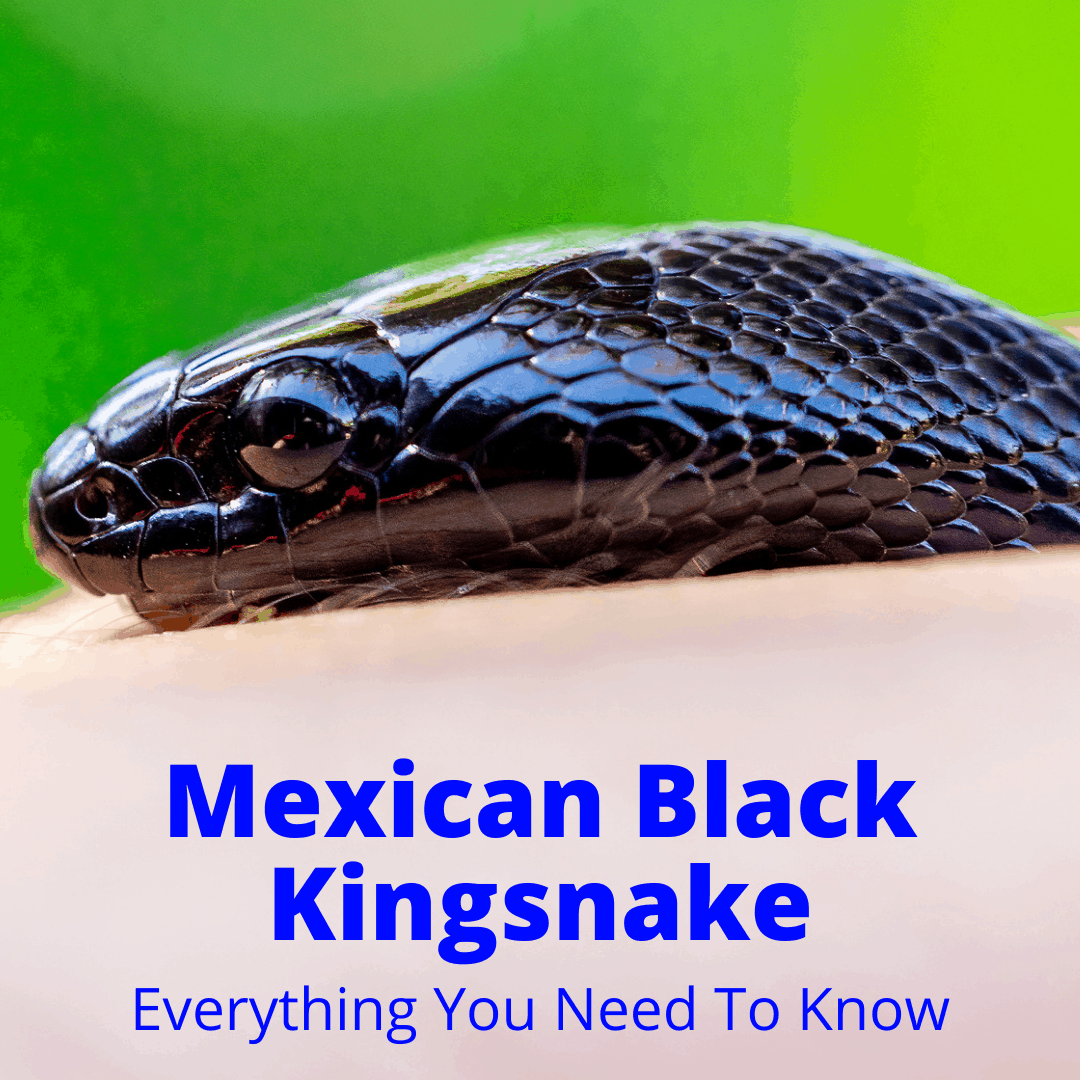
It makes sense. It has a cool look, is highly adaptable and does well in captivity.
Even better, it is not nocturnal.
That makes it an entertaining pet to own, because it is active while you are awake.
It is a great snake for beginners, too. It is not venomous, does not get too large and is docile.
But it also has some drawbacks. It’s not for everyone.
Keep reading to learn everything you need to know about caring for a Mexican Black Kingsnake, and to help you figure out if it is the right pet for you
Table of Contents
- 1 Mexican Black Kingsnake Size And Appearance
- 2 Mexican Black Kingsnake Habitat
- 3 Mexican Black Kingsnake Lifespan
- 4 Mexican Black Kingsnake Pet Care: Diet
- 5 Mexican Black Kingsnake Enclosure
- 6 Baby Mexican Black Kingsnake
- 7 Mexican Black Kingsnake Temperament
- 8 Is The Mexican Black Kingsnakes Poisonous?
- 9 Mexican Black Kingsnake Morphs
- 10 Different Types Of Kingsnakes
- 11 Reproduction
- 12 Do Mexican Black Snakes Brumate?
- 13 Additional Questions
- 14 Final Thoughts
Mexican Black Kingsnake Size And Appearance
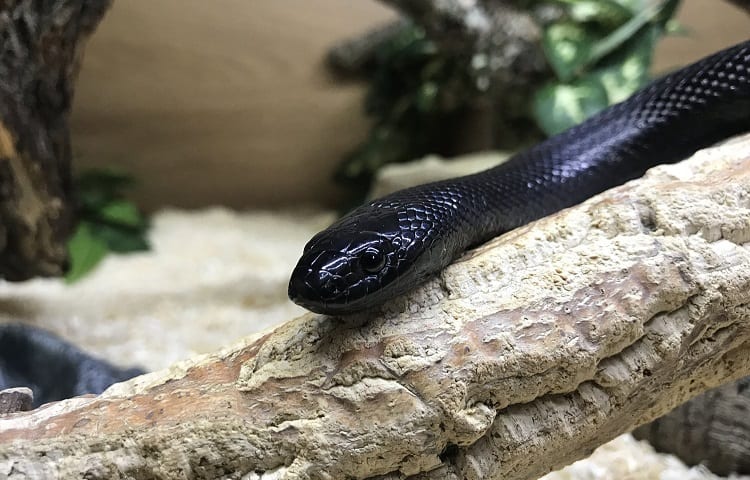
The Mexican Black Kingsnake has a completely black body that doesn’t have any patterns on it. It is never black and yellow.
While that might sound boring, especially if you want to have a cool-looking snake, it actually has a pretty amazing secret feature.
When it lies in the sun, its skin takes on an enamel-like appearance. It looks blue and glows in the light!
When they’re juveniles, these snakes sometimes have white spots around their necks, but they fade with age and sometimes disappear entirely.
These snakes can grow to be quite large and males and females are the same length. Mexican Black Kingsnakes grow to approximately four feet in length and they reach full size after three years.
They’re pretty easy to accommodate because they’re not as large as some other snakes. That makes them one of the best black snake pets, even for first-time snake owners.
Mexican Black Kingsnake Habitat

These snakes hail from the Sonora and Sinaloa deserts in Mexico and the southern US. They can be found as far north as the southern regions of Arizona, but don’t make it into neighboring New Mexico.
However, in the US, the Mexican Black Kingsnake is usually bred with other snakes, like the California Kingsnake or desert Kingsnake.
This snake thrives in the desert but you might also find them in semi-arid grasslands or shrublands. They tend to hide away in secret places, such as rodent burrows.
This is because it gets too hot for them during the day. Burrowing is one of their defining features and that’s something you’ll need to consider if you want to adopt a Mexican black kingsnake.
Mexican Black Kingsnake Lifespan
In captivity, Mexican Black Kingsnakes can live for up to 20 years, provided that they are looked after properly.
In the wild, they tend to have a lifespan of approximately nine years or less.
The reason for such a discrepancy, is because snakes are much more prone to dangers and illnesses in the wild, where they can’t be given medical attention if required.
In addition, Mexican Black Kingsnakes have various predators, like foxes, coyotes, feral cats, owls, and hawks. However, their all-black appearance helps camouflage them when they move around at night, when predators are active.
Mexican Black Kingsnake Pet Care: Diet
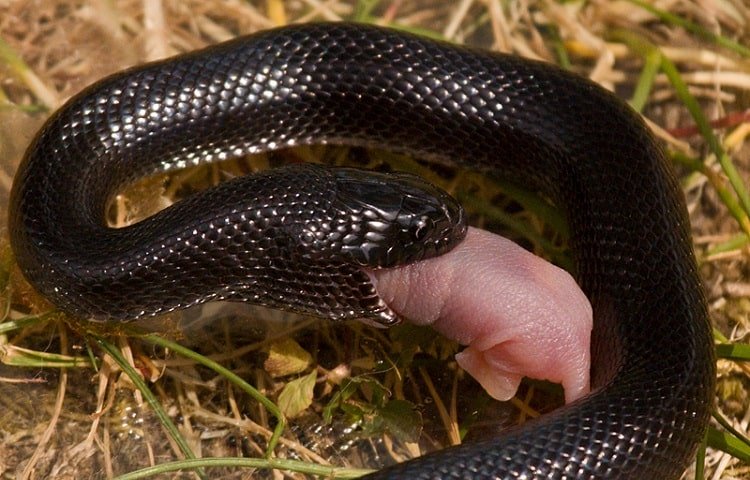
In the wild, Mexican Black Kingsnakes feed on a variety of prey that includes rodents, lizards, eggs, birds, and toads. Sometimes they can even feed on other snakes.
They are immune to pit viper venom. This means that they are capable of killing and eating venomous snakes like rattlesnakes, especially young rattlesnakes.
They are constrictor snakes equipped with expanding jaws so they are able to prey on snakes that are as large as they are.
If that sounds a little intimidating to you as a snake owner interested in owning a Mexican Black Kingsnake, don’t worry. When they’re kept as pets, these snakes remain healthy on a diet of frozen mice.
It’s never a good idea to give your Mexican Black Kingsnake live mice that they can hunt and eat because the mice might try to fight off the snake and scratch it, which can harm your pet.
How Often Should You Feed Them?
This type of snake will do well when fed every 10 to 14 days if it’s an adult, but babies need to be fed every five days because they are still growing.
When these snakes reach the age of one year, you should feed them every seven to 10 days.
One of the big questions when it comes to owning any snake is how much you should feed it at mealtimes.
For this snake, it’s good to follow this guideline: feed it enough so that you can see a small lump in its stomach after a meal. Make sure you don’t overfeed it!
Sometimes your snake will go a longer time without eating. This is most common when shedding and is usually nothing to worry about, but you do want to make sure it is not showing any signs of illness.
If your snake is refusing food and you don’t know why, read this article.
Mexican Black Kingsnake Enclosure
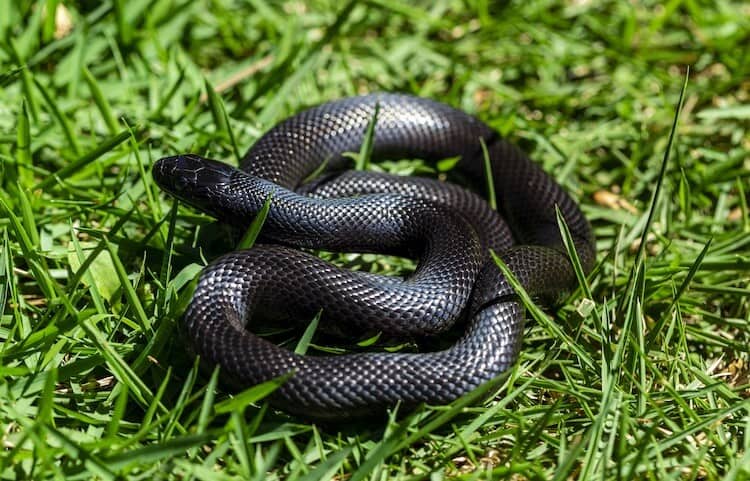
When in the wild, these snakes like to live on or near the ground. That said, they are good climbers and swimmers!
You should try to mimic their natural environment as much as possible. So, with that in mind, here are some good tips for creating the perfect habitat for your pet.
Enclosure
The enclosure should be made of glass or ventilated plastic. These materials do better in the humidity your snake requires. The ideal enclosure should have at least a 40-gallon capacity to accommodate your snake comfortably.
Substrate
There are different kinds of substrates for reptiles on the market so it can sometimes be difficult to know which one to get.
Since Mexican Black Kingsnakes love to burrow in the wild, you should ensure that you give them a bedding material in which they can burrow. A good choice of substrate is aspen shavings or cypress mulch.
Temperature
Make sure that the ambient temperature of your snake’s enclosure is between 75° and 80° Fahrenheit. It should have a basking temperature of 88° to 90° Fahrenheit.
Invest in a quality thermostat so you can make sure the temperatures are correct.
You’ll need some kind of heater to get the appropriate temperatures, especially for the basking spot. You can use an under-tank heat mat or ceramic heat bulb for this.
The heat mat is great because it will give your snake belly heat, but be careful because this can become very hot. Make sure you connect the heat mat to a thermostat to avoid the temperature getting too high.
Note that if you have a thick substrate or bedding in your snake’s enclosure, this will prevent the heat from penetrating it and getting to your snake.
Since this snake likes to burrow, chances are the substrate will be thick, so overheat heating might make more sense.
Use a heat lamp or ceramic heat emitter for this purpose. Make sure you connect the bulb to a pulse proportional thermostat that tweaks the amount of energy supplied to the bulb and reduces it if it’s too hot for your snake.
Humidity
As desert creatures, Mexican Black Kingsnakes don’t require much humidity. You should aim to keep it between 40 and 60 percent.

This will ensure that your snake has the moisture it needs to be healthy. You should provide it with a small body of water to swim and lie in.
Invest in a good reptile hygrometer so that you can measure the level of humidity in your snake’s cage.
Always have a misting bottle of water handy. If you see the humidity has dropped, you should spray the enclosure.
You don’t need a humidifier for this type of snake, but you may need to decrease the humidity, if you live in a humid location.
Hiding Places And Climbing Accessories
Fill the enclosure with rocks, vegetation, and other décor items so that the snakes can use them to climb.
You should also ensure that there are enough areas in the enclosure where your snake can hide. You should have at least one hiding spot in the basking area and one on the cooler side of the enclosure.
Baby Mexican Black Kingsnake
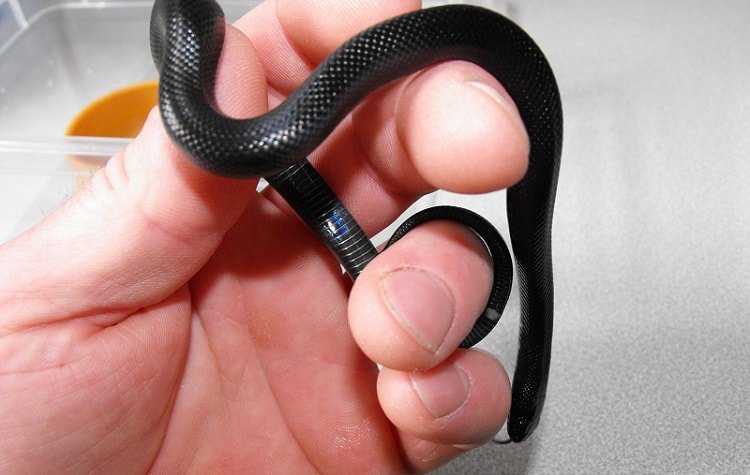
If you want to own baby Mexican Black Kingsnakes, you should handle them from a very young age so that they get used.
If they’re no used to it, being handled can be a stressful experience that could cause them to hiss or even strike.
Although young snakes can be a bit temperamental, once they feel comfortable in their habitat and become used to being handled, they will become calmer and less defensive.
Mexican Black Kingsnake Temperament
When it reaches adulthood, a Mexican Black Kingsnake can be quite docile.
Sometimes these snakes are known for being a little snappy, but they tend to outgrow this. It helps to spend time with them when you’re not feeding them.
That way, they don’t only associate you with food and will start to feel more comfortable around you.
Do Mexican Black Kingsnakes Like To Be Handled?
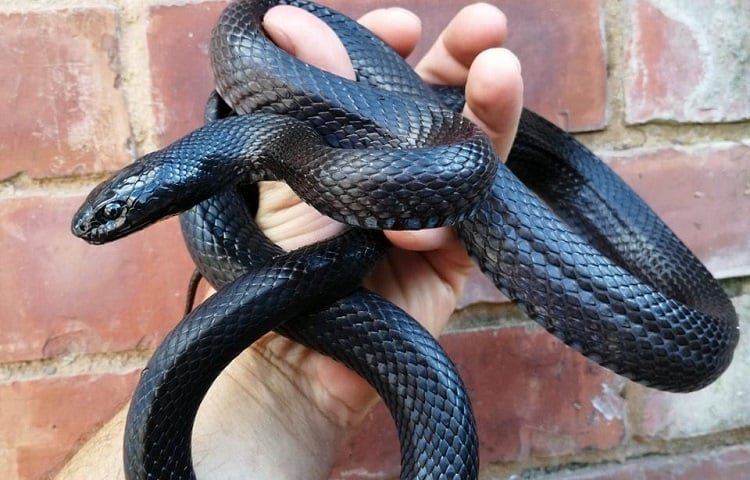
Since snakes aren’t affectionate, they don’t gravitate towards being held. But this species tolerates being handled. When you pick it up, make sure you hold it correctly.
These snakes aren’t arboreal, so they won’t climb over your hands and arms. This means you need to give them enough support.
You can do this by holding their bodies about one-third and two-thirds of the way.
As with any snakes, they don’t like quick or sudden movements. You should also never bring them too close to your face because snakes see this as aggressive.
Similarly, you should never handle a snake when it’s waiting for its meal as it might strike at you, thinking that you have food. Do not handle your snake too often, because this can cause it to become stressed.
If you handle your properly and get it used to you, it will become more tame. This is one of the reasons why they’re such a popular snake to own.
Is The Mexican Black Kingsnakes Poisonous?
Although they are strong enough to consume venomous snakes without being harmed, the Mexican Black Kingsnake is a non-venomous snake.
That said, these snakes can seem a bit intimidating because of how they constrict their prey to kill it instead of biting it or squeezing it with their jaws. They are actually the strongest constrictors on earth, on a pound for pound basis.
Mexican Black Kingsnake Morphs
Although they’re naturally beautiful, some people like to breed these snakes so that they can look a little more unique.
With their dark skins, these snakes do lend themselves to some beautiful morphs. But they are not as readily available as some other types of snakes.
For example, if you’re looking for a Rainbow Boa morph, you’ll find a range of different ones, with one being more eye-catching than the next.
With the Mexican Black Kingsnake, you’re pretty limited when it comes to what you can find. An example is the granite morph.
This is quite striking as the snake has the classic black body of a wild-caught Mexican Black Kingsnake, but it has grey patterns all along its length. These patterns produce a speckled, cracked appearance, which is probably why this snake got the name granite.
You can also find granite morphs that have a bit of red in them, which adds to their visual appeal. There are also ultra-granite morphs of this snake. These display the same granite appearance, but the markings are smaller so they look more detailed.
The more common and popular California Kingsnake has far more morphs available to the public.
Different Types Of Kingsnakes
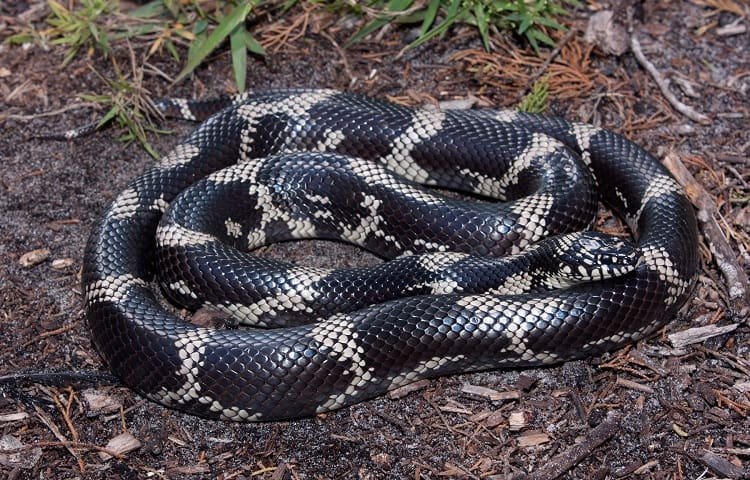
There are six types of kingsnakes that are all defined by smooth scales and a range of colors. They’re all nonvenomous. Here’s a brief summary of the different types.
Common Kingsnakes
These snakes have bright red, orange, tan, and yellow skins that can be spotted, striped, or speckled. The California Kingsnake is a popular type of common kingsnake.
These snakes can live in a variety of environments, such as wetlands, valleys, and deserts. You can find them in the U.S. as well as in northern and central Mexico.
California Mountain Kingsnake
This type of kingsnake is similar in appearance to the venomous coral snake from Arizona. If you come across these snakes, you might battle to tell them apart.
Here’s a quick tip to remember whenever you’re outdoors: the California Mountain Kingsnake has yellow and red bands, and they’re always separated by a black band.
You can find these nonvenomous snakes from Baja California all the way to Washington, but they’re not easily spotted because they’re quite reclusive.
Prairie Kingsnake
This kingsnake tends to be gray, olive, brown, or tan in color. You can find it in prairies and fields in the southern United States. It loves warmer climates and will be less visible during the winter when it hibernates.
Sonoran Mountain Kingsnake
This type of kingsnake has white, black, and red bands on its body. It also has a striking cream-colored snout so you can easily tell it apart from other types of kingsnakes.
This snake loves to live in the mountains in Arizona, but you can sometimes see it in valleys. These kingsnakes are excellent climbers so don’t be surprised if you spot one in a tree.
Gray-Banded Kingsnake
Living up to its name, this kingsnake has a gray body and multicolored bands on it. It can be found in Texas and New Mexico, as well as northern Mexico. These snakes like to live in hills, ridges, canyons, and deserts.
Mexican Black Kingsnake
This is the least colorful out of all the kingsnakes! But there is something to be said for its dark body that makes it a unique snake worth owning.
It also glows in the light, which is a feature that gives it something special. Even when it’s not in the light, this snake has a glossy appearance that makes its black skin really elegant.
Reproduction
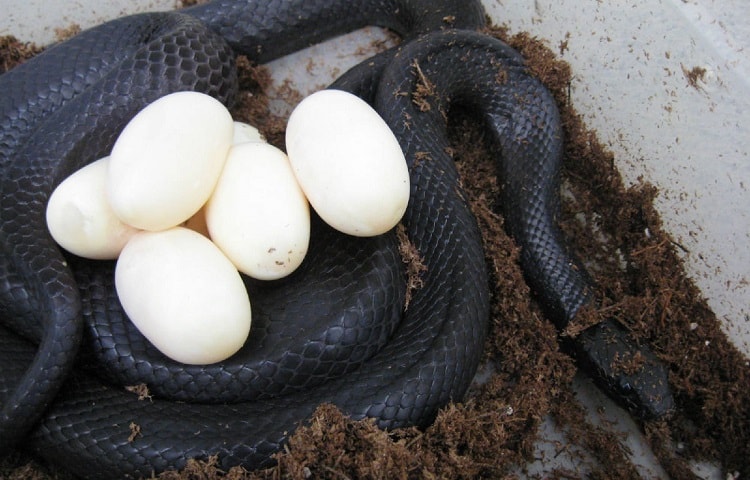
For the Mexican Black Kingsnake, spring is when mating season begins.
These snakes are oviparous. This means that they lay eggs. Female snakes can lay up to 24 eggs in one clutch. Just like with many other snakes, female Mexican Black Kingsnakes don’t give any care to their hatchlings.
The hatchlings need to be incubated for 50 to 60 days before they are born. As soon as they are born, they need to look after themselves.
As we mentioned earlier, Mexican Black Kingsnakes grow really fast, and they can reach maturity within two or even three years.
Do Mexican Black Snakes Brumate?
When the temperatures become really cold in the winter, snakes become less active. Although they don’t hibernate, they do slow down to conserve energy and this is known as brumation.
This is not something that you need to worry about with your captive Mexican Black Kingsnake, because these snakes can remain active all year round. In the wild, these snakes don’t brumate.
That said, if you want to breed them, you will need to induce brumation. This should be done for about three months, during which time you should decrease the enclosure’s temperature a little – aim for between 45° and 55° Fahrenheit.
When your snake enters brumation, you need to provide a fresh supply of water and adequate ventilation in the enclosure. When the brumation period is over, you can slowly increase the air temperature for your snake. Give it food so that it will shed its skin.
Once the female snake has shed her skin, she will be ready for ovulation and will release pheromones that attract male snakes.
At this time, you will be able to put a male in the enclosure. Never leave the snakes unattended because you don’t want them to hurt (or eat!) each other. The female snake will lay her eggs two months later.
Breeding is the only time you should ever house two Mexican Black Kingsnakes together. Once your snakes have mated, you should separate them immediately to prevent problems from occurring.
Additional Questions
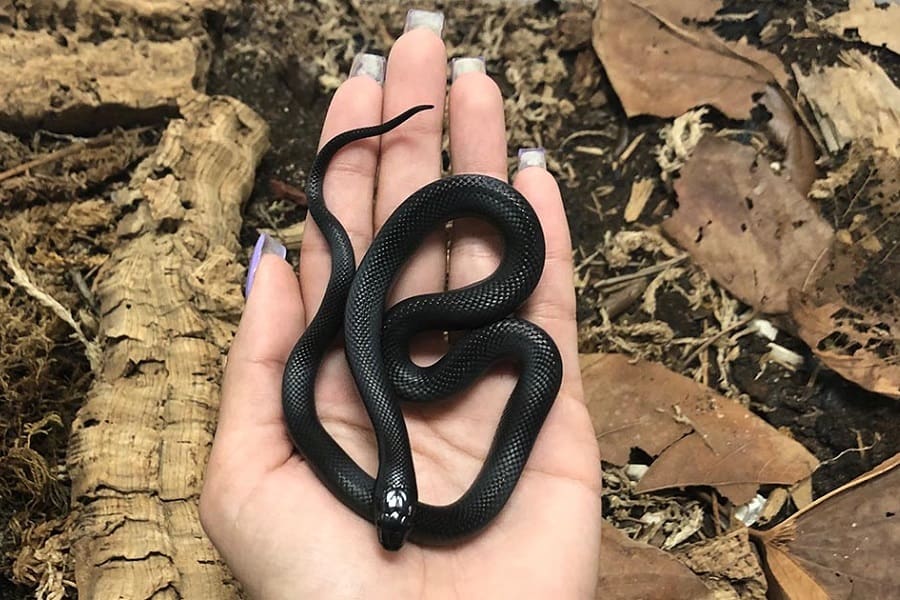
Are Mexican Black Kingsnakes immune to rattlesnake venom?
This is a common misconception. This snake is resistant to rattlesnake venom, but it is not immune to the snake’s venom.
Do Mexican Black Kingsnakes actively hunt other snakes?
These snakes will eat whatever prey is available to them, even if that happens to be another snake. But they don’t go out of their way to hunt other snakes.
Do Mexican Black Kingsnakes rattle their tails?
These snakes behave like rattlesnakes when they are threatened or cornered – they rattle their tails, bite, and hiss!
But they don’t have rattles. Instead, they shake their tails which can make a rattling sound.
Final Thoughts
If you’re looking for a snake to keep as a pet that has unique and interesting characteristics without being poisonous, the Mexican Black Kingsnake is a good choice.
It’s pretty easy to look after, so it’s great for beginners. It also has a striking appearance that is sure to impress.
In this article, we’ve outlined everything you need to know about keeping the Mexican Black Kingsnake as a pet, from the type of enclosure it needs, to the food it likes to eat, and whether or not it’s a snake that you can handle with ease.
If you know you want a black snake, but are not sure this one is right for you, there are other options. One of the best as a pet is the black rat snake. We have an article comparing the black rat snake vs black racer, which is not a good snake pet.
Leave a Reply